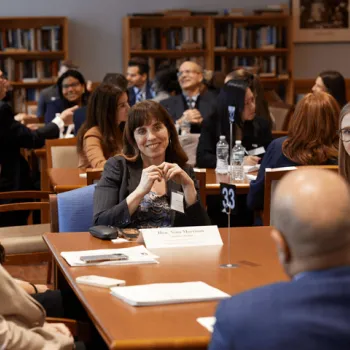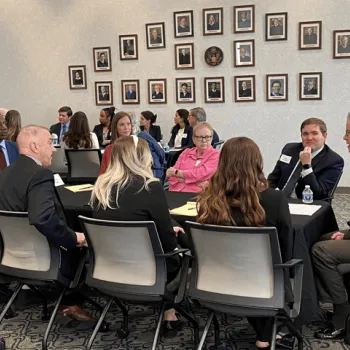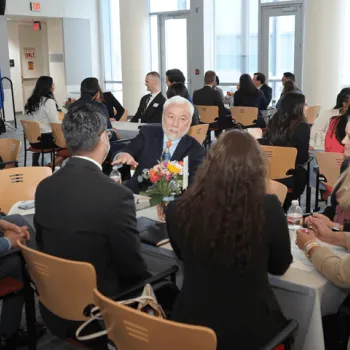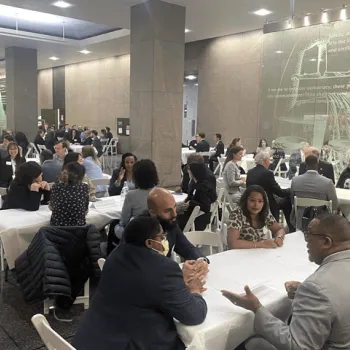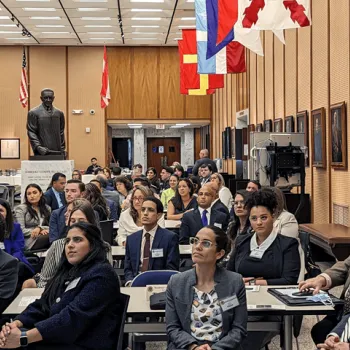About 2,000 attorneys and law students spoke with federal judges during a recent symposium, which was simultaneously broadcast in 38 cities, about the many paths to becoming a bankruptcy or magistrate judge.
“The more we share our own journeys to the bench with those in the legal field, the more we demystify the judicial position and application process,” said Judge Stephanie Dawkins Davis, of the Sixth Circuit U.S. Court of Appeals. “People often think of judges as these larger-than-life figures, but really, we’re all just people. And many of the people I speak with at events like this are just as qualified, if not more.”
The April 3 event, titled “Roadways to the Bench: Who Me? A Bankruptcy or Magistrate Judge?” was sponsored by the Judicial Conference Committees on the Administration of the Bankruptcy System and the Administration of the Magistrate Judges System. Law students and lawyers were encouraged to consider pursuing Judiciary career opportunities, with the goal of expanding the pipeline of candidates for the bankruptcy and magistrate judges’ bench.
Unlike appellate and district judges, who are nominated by the President and confirmed to life terms by the Senate, bankruptcy and magistrate judges are appointed by other judges to renewable terms.
The thought, “Who me?” echoed in now-Magistrate Judge Shaniek Mills Maynard’s mind as she wrestled with the decision to apply for a seat in the Southern District of Florida in 2017.
“I didn’t think of myself as the most likely candidate, there wasn’t really anyone who looked like me on the bench in the county where I lived. Plus, I had spent the last three years outside of the courtroom running a non-profit,” Maynard said. "I think a lot of very good, very qualified lawyers rule themselves out because they don’t think they fit the mold.”
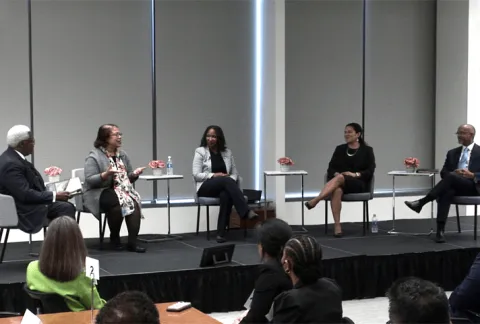
A panel of federal judges kick-off the Roadways to the Bench program.
A panel of federal judges, meeting at the District of Columbia Bar headquarters, kicked off the event by explaining the magistrate judge and bankruptcy judgeship application process, how to succeed as a judge, and the importance of diversity on the bench. The panelists were: Judge Stephanie Dawkins Davis; Judge Laura Taylor Swain, of the U.S. District Court for the Southern District of New York; Judge Kesha L. Tanabe, of the U.S. Bankruptcy Court for the District of Minnesota; Magistrate Judge Mustafa T. Kasubhai, of the U.S. District Court for the District of Oregon; and Judge Carl E. Stewart, of the Fifth Circuit U.S. Court of Appeals, who moderated.
This is the Judiciary’s second iteration of the national diversity event for law students and attorneys. The last program in 2019 informed law students and attorneys about federal judgeships, with a spotlight on the bankruptcy bench and bar. Afterward, a number of attendees applied for bankruptcy judgeships, and at least 10 have since joined the bench. The Roadways program aligns with the Strategic Plan for the Federal Judiciary, said Maynard and Bankruptcy Judge Peter D. Russin, who both participated at the Miami event location.
“Diversity promotes public confidence in the judicial system,” Russin said. “We all bring different life experiences to our sense of justice. Diverse life experiences on the Judiciary allows the Judiciary to better reflect the society it serves, which is fundamental to achieving true justice.”
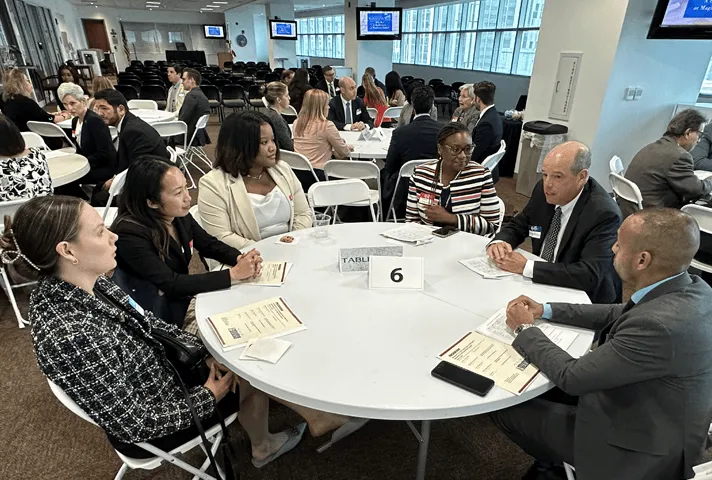
Magistrate Judge Shaniek Mills Maynard (third from right) and Bankruptcy Judge Peter D. Russin (second from right) share their insights with participants at the Miami roundtable session.
Following the broadcast, each location hosted roundtable discussions. Approximately 600 federal judges attended the discussions throughout the country to speak with participants in small group settings about their paths to the bench and careers in the law.
Veronica Brown-Moseley, a consumer bankruptcy attorney in Richmond, Virginia, who attended the program for the second time, said the opportunity to be in a room full of judges is priceless.
“It’s just such an inspiring program. It’s rare to have the opportunity to meet judges from all around the country, build relationships, learn from their experiences, gain insights, and learn about the skills that would be helpful for an aspiring judge,” she said.
Andrew O’Keefe, a law clerk who attended the event in Phoenix, said, “Judges can seem unapproachable because they are in this very esteemed position. But having the opportunity to hear their story and speak to them in a more intimate setting helps relieve those nerves.”
Presley Klinger, a law student who attended the event in New York City, said, “Getting to be across the table from a judge is something that doesn't happen frequently, especially as a law student. We had conversations about who they are, what they bring to the bench, and the perspectives that they have.”
Judges who participated in the symposium agreed that interacting with students and lawyers outside the courtroom is an important step in casting a wider net to attract the broadest possible pool of qualified applicants.
“There are so many people who have questions and are interested in joining the federal bench, but don't know who to ask or where to go,” said Magistrate Judge Sarah L. Cave, of the Southern District of New York. “The event creates an opportunity for those questions to be answered and for participants to realize that they too can gain or already possess many of the attributes that would make them a wonderful candidate to serve as a federal court judge.”
“We hope participants leave the event convinced that the judicial path is open to everyone,” Davis said.
Magistrate Judges: The Merit Selection Process
Learn what it takes to qualify as a federal magistrate judge and about the selection process.
Subscribe to News Updates
Subscribe to be notified when the news section is updated.

